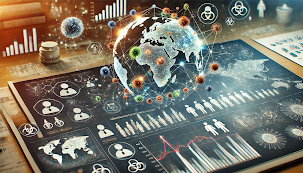Epidemiological Modeling: Using networks to predict and control disease spread
Network Science in Epidemiology
Nodes and Edges:
- Nodes represent individuals, populations, or regions in a network.
- Edges signify interactions, such as physical contact, shared environments, or transportation links, which facilitate disease transmission.
Network Types:
- Contact Networks: Track direct interactions between individuals, such as family members, coworkers, or healthcare workers.
- Spatial Networks: Represent geographical connections, such as travel patterns and urban layouts.
- Airline and Transportation Networks: Analyze disease spread via global mobility.
Key Features of Epidemiological Models
Disease Transmission Dynamics:
- Models simulate how diseases spread, accounting for factors like contact rates, infectiousness, and recovery time.
- Common models include SIR (Susceptible-Infectious-Recovered) and SEIR (Susceptible-Exposed-Infectious-Recovered).
Identification of Super-Spreaders:
- Network analysis pinpoints individuals or locations that disproportionately drive transmission, enabling targeted interventions.
Hotspot Detection:
- By analyzing clusters and high-degree nodes, models reveal areas or groups at greater risk, aiding resource allocation.
Temporal Analysis:
- Dynamic networks track changes over time, helping forecast outbreak progression and evaluate the effectiveness of interventions.
Applications of Epidemiological Modeling
Pandemic Preparedness:
- Models inform strategies for emerging diseases like COVID-19, identifying critical points for containment and mitigation.
Vaccine Distribution:
- Network analysis determines optimal vaccination strategies, prioritizing high-risk nodes and pathways.
Quarantine and Isolation:
- Models evaluate the impact of isolating specific individuals or groups, reducing disease spread while minimizing social disruption.
Contact Tracing:
- Tools map potential chains of infection, enabling faster and more efficient containment efforts.
Healthcare Resource Allocation:
- Predictive models assist in distributing medical supplies, hospital beds, and personnel based on projected needs.
Challenges in Epidemiological Modeling
Data Quality and Availability:
- Accurate models require detailed data on interactions, demographics, and disease characteristics, which can be difficult to obtain.
Model Complexity:
- Balancing simplicity and accuracy is crucial, as overly complex models may become impractical or computationally intensive.
Uncertainty and Variability:
- Disease behavior, human interactions, and external factors (e.g., weather, policy changes) introduce uncertainty in predictions.
Ethical and Privacy Concerns:
- Data collection, particularly in contact tracing, must balance public health benefits with individual privacy.
Benefits of Network-Based Epidemiological Models
Precision in Interventions:
- Targeted actions reduce the need for widespread restrictions, minimizing economic and social impacts.
Early Warning Systems:
- Models detect emerging outbreaks, enabling proactive responses.
Scenario Planning:
- Simulating various scenarios helps policymakers prepare for potential outcomes and uncertainties.
Global Connectivity Insights:
- Analyzing international networks highlights pathways for global disease spread, supporting coordinated responses.
Future of Epidemiological Modeling
Advancements in network science, big data, and artificial intelligence are revolutionizing epidemiological modeling. Real-time data streams from social media, mobile devices, and wearable technology enhance model accuracy. Integration with machine learning enables adaptive modeling, improving predictions and responses. As global health challenges grow, network-based epidemiological modeling will remain essential in safeguarding public health.


Comments
Post a Comment